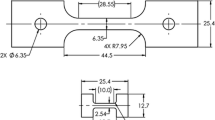Abstract
The susceptibility of austenitic stainless steels to the formation of two distinct weld defects, solidification cracking and lack of penetration, is related to the chemical composition of the base and filler material. The propensity for cracking is determined primarily by the solidification mode and the amount of residual tramp elements such as phosphorous and sulfur. High sulfur levels can lead to weld centerline cracking and heat affected zone (HAZ) cracking while very low sulfur levels (less than ∼50 ppm) in types 304L and 316L are associated with lack of penetration weld defects and a distinct loss in puddle control during fusion welding. A calculated Creq to Nieq ratio of 1.52 to 1.9 is recommended to control the primary mode of solidification and prevent solidification cracks in type 304L while the Creq/Nieq ratio of 1.42 to 1.9 is recommended for type 316L stainless steel. A lower limit of 50 ppm sulfur is recommended to avoid possible lack of penetration. These ranges should be validated by welding trials for specific weld processes and applications.
Similar content being viewed by others
References
J.A. Brooks and J.C. Lippold: inMetals Handbook, vol. 6,Welding, Brazing, and Soldering, ASM International, Materials Park, OH, 1993, pp. 456–470.
ASME 1998 Section II, AMSE SA-182/SA-182M,Specification for Forged or Rolled Alloy-Steel Pipe Flanges, Forged Fittings, and Valves and Parts for High-Temperature Service, ASME, New York, NY, 1998, pp. 229–49.
ASME 1998 Section II, AMSE SA-240/SA-240M,Specification for Heat-Resisting Chromium and Chromium-Nickel Stainless Steel Plate, Sheet, and Strip for Pressure Vessels, ASME, New York, NY, 1998, pp. 363–70.i.
ASME 1998 Section II, ASME SA-312/SA-312M,Specification for Seamless and Welded Austenitic Stainless Steel Pipes, ASME, New York, NY, 1998, pp. 477–90.
ASME 1998 Section II, AMSE SFA-5.9,Specification for Bare Stainless Steel Welding Electrodes and Rods, ASME, New York, NY, 1998, pp. 203–27.
A.L. Schaeffler:Metal Progress, 1949, vol. 56, pp. 680–680B.
W.T. DeLong, G. A. Osram, and E. R. Szumachowski:Weld Journal, 1956, vol. 35, pp. 521s-28s.
O. Hammar and U. Svensson:Solidification and Casting of Metals, The Metals Society, London, 1797, pp. 401–10.
D.J. Kotecki and T.A. Siewert:Welding Research Supplement, 1992, pp. 171s–77s.
F.C. Hull:Welding Journal, vol. 46, 1967, pp. 399s-409s.
Welding Handbook, vol. 4,Materials and Applications Part 2, 8th ed., W.R. Oates and A.M. Saitta, ed., American Welding Society, Miami, FL, 1998, p. 269.
T. Takalo, N. Suutala, and T. Moisio:Metall. Trans., vol. 10A, 1979, pp. 1173–81.
L. Li, and R.W. Messler, Jr.:Welding Journal, vol. 71, 1999, pp. 171s-179s.
J.A. Brooks, S.H. Goods, and C.V. Robino: Sandia Report Sand2000-8002, Sandia National Laboratories, Albuquerque, NM, 2000.
Author information
Authors and Affiliations
Rights and permissions
About this article
Cite this article
Korinko, P.S., Malene, S.H. Considerations for the weldability of types 304L and 316L stainless steel. Practical Failure Analysis 1, 61–68 (2001). https://doi.org/10.1007/BF02715336
Received:
Revised:
Issue Date:
DOI: https://doi.org/10.1007/BF02715336




